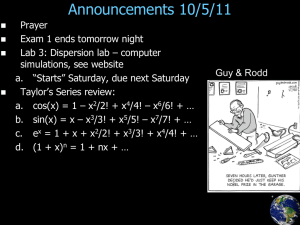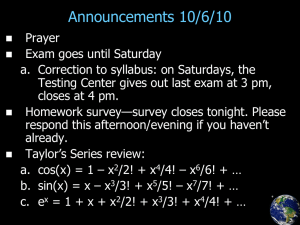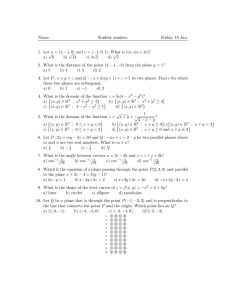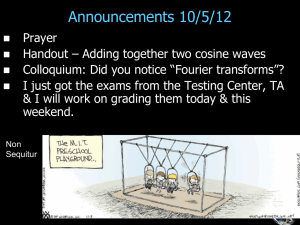lecture 16 - complex numbers
advertisement
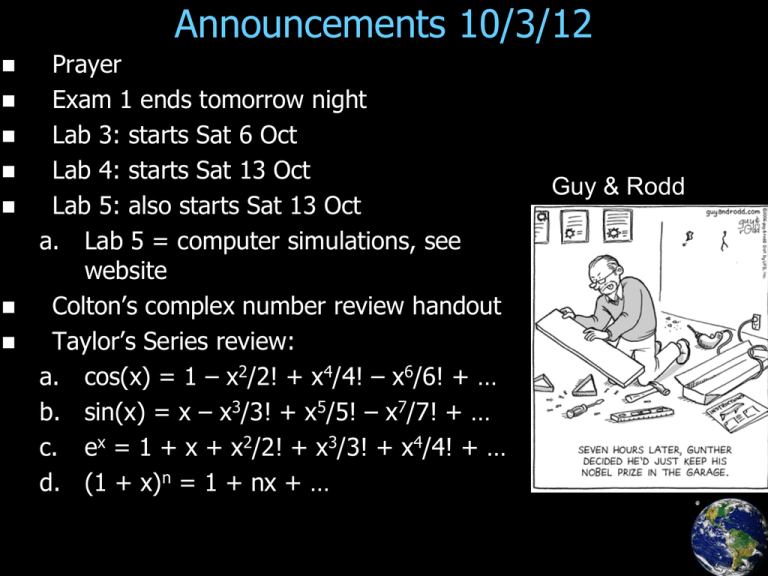
Announcements 10/3/12
Prayer
Exam 1 ends tomorrow night
Lab 3: starts Sat 6 Oct
Lab 4: starts Sat 13 Oct
Lab 5: also starts Sat 13 Oct
a. Lab 5 = computer simulations, see
website
Colton’s complex number review handout
Taylor’s Series review:
a. cos(x) = 1 – x2/2! + x4/4! – x6/6! + …
b. sin(x) = x – x3/3! + x5/5! – x7/7! + …
c. ex = 1 + x + x2/2! + x3/3! + x4/4! + …
d. (1 + x)n = 1 + nx + …
Guy & Rodd
From warmup
Extra time on?
a. (nothing in particular)
Other comments?
a. The book is really funny...
b. If this has been my favorite section to read so
far, what field of physics should I go into?
Optics?
Complex Number Basics
What’s the square root of -1?
What’s the difference between i and –i?
The Complex Plane
a. How to plot 3 + 4i? Or -10 + 10i?
b. What does “take the complex conjugate” mean,
graphically?
Warmup question:
What’s the complex conjugate of:
a.
1 3i
4 5i
1 3i
4 5i
just switch all i’s to –i’s
1 3i
or… much
longer method…4 5i 4 5i 4 5i
1 3i 4 5i
4 5i 12i 15
16 25
11 17i
41
11 17
i
41 41
11 17
C.C.
i (the same!)
41 41
From warmup
Consider the collection of all points in the
complex plane that have the same magnitude-for the sake of discussion let's say the
magnitude is 5. What's special about this group
of points?
a. They form a circle with radius 5.
Complex Numbers – Polar Coordinates
Where is 10ei(p/6) located on complex plane?
Proof that it is really the same as 1030
Complex Numbers, cont.
Adding
a. …on complex plane, graphically?
Multiplying
a. …on complex plane, graphically?
b. How many solutions are there to x2=1? x2=-1?
c. What are the solutions to x5=1? (xxxxx=1)
Subtracting and dividing
a. …on complex plane, graphically?
Polar/rectangular conversion
Warning about rectangular-to-polar conversion:
tan-1(-1/2) = ?
a. Do you mean to find the angle for (2,-1) or
(-2,1)?
Always draw a picture!!
Using complex numbers to add sines/cosines
Fact: when you add two sines or cosines having
the same frequency, you get a sine wave with the
same frequency!
a. “Proof” with Mathematica
Worked problem: how do you find mathematically
what the amplitude and phase are?
Summary of method:
Just like adding vectors!!
HW 16.5: Solving Newton’s 2nd Law
Simple Harmonic Oscillator
(ex.: Newton 2nd Law for mass on spring)
2
d x
k
x
2
m
dt
Guess a solution like
x(t ) Ae
it
what it means, really: x(t ) A cos(t )
and take Re{ … } of each side
(“Re” = “real part”)
Complex numbers & traveling waves
Traveling wave: A cos(kx – t + )
Write as:
f (t ) Ae
i kx t
i i kx t
Often: f (t ) Ae e
…or
f (t ) Ae
i kx t
– where A = “A-tilde” = a complex number
the amplitude of which represents the amplitude of
the wave
the phase of which represents the phase of the wave
– often the tilde is even left off
Clicker questions:
Which of these are the same?
(1) A cos(kx – t)
(2) A cos(kx + t)
(3) A cos(–kx – t)
a.
b.
c.
d.
(1) and (2)
(1) and (3)
(2) and (3)
(1), (2), and (3)
Which should we use for a left-moving wave: (2) or (3)?
a. Convention: Usually use #3, Aei(-kx-t)
b. Reasons: (1) All terms will have same e-it factor. (2)
The sign of the number multiplying x then indicates
the direction the wave is traveling.
k k iˆ
Reflection/transmission at boundaries: The setup
x=0
Region 1: light string
in-going wave
reflected wave
i ( k1x1t )
transmitted wave
AI e
i ( k1x1t )
ARe
i ( k1x1t )
f1 AI e
Region 2: heavier string
Goal: How much of wave is
transmitted and reflected?
(assume k’s and ’s are known)
i ( k1x1t )
ARe
f1 AI cos(k1x 1t I ) AR cos(k1x 1t R )
AT ei ( k2 x2t )
i ( k2 x2t )
f2 AT e
f 2 AT cos(k2 x 2t T )
Why are k and the same for I and R? (both labeled k1 and 1)
“The Rules” (aka “boundary conditions”)
a. At boundary: f1 = f2
b. At boundary: df1/dx = df2/dx
